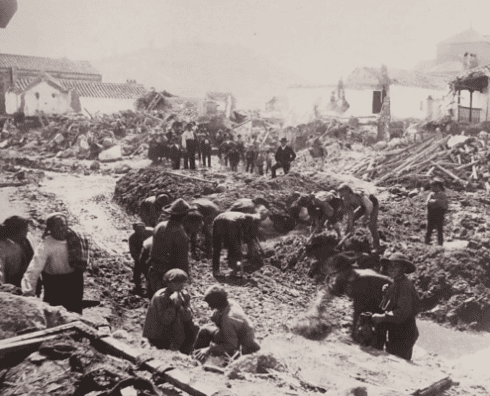VALENCIA is ground zero for the worst natural disaster to hit Spain in a century, claiming at least 95 lives.
But it is certainly not the first time that mother nature has unleashed her power upon the country.
Going back to the 19th century, Spain has regularly been pummelled by weather systems unique to the area.
Tuesday’s devastation was caused by a powerful weather phenomenon common to the Mediterranean region known in Spanish as a gota fría (cold drop).
READ MORE: Spain suffers deadliest floods in over a century as 95 people are killed following DANA storms

It occurs when cold air above meets warm, humid air below, triggering intense, sudden downpours that often lead to severe flooding and damage.
Meanwhile, a DANA (Depresión Aislada en Niveles Altos, or Isolated Depression at High Levels) refers to a high-altitude, isolated pocket of cold air that breaks off from the polar jet stream and moves southward over warm Mediterranean air.
Although a DANA and a gota fria often produce the same outcome, the two are not identical.
READ MORE: What is a DANA? The weather phenomenon behind this week’s deadly floods in Spain

But Tuesday, October 29 was certainly not the first time Spain has been battered by either a Dana or a gota fria, going back to the 19th century.
As X user Carlos Design (@carlosdesign1) explains:
Toledo and Almería, 11 September 1891
On this day, a sudden gota fría (cold drop) struck nearly the entire province of Almería, causing rivers and seasonal streams to overflow.
The floods left dozens dead, leading authorities to redirect the course of the Belén stream through the city of Almería as a preventative measure.
On the same day 360km away, the Amarguillo River overflowed in what became known as the Consuegra Flood, devastating the town of Toledo and causing the deaths of 359 people.
This disaster remains the deadliest natural catastrophe in the history of Toledo province.



Vic, Catalunya, 8 October 1863
A severe flood known as La Gran Riuada de Vic devastated the city of Vic in the early hours.
The Méder River rose by over seven metres in certain areas, collapsing more than 30 houses and sweeping away trees, livestock, and residents in its path.
READ MORE: British expat, 71, is killed by deadly floods in Spain’s Andalucia
Barcelona, 15 September 1862
On 15 September 1862, Barcelona suffered one of its worst meteorological disasters, a flood that took nearly 1,000 lives.
Neighbourhoods were inundated, and businesses destroyed, with La Rambla experiencing the brunt of the torrential rains.


Valencia, 14 October 1957
The Gran Riada de Valencia (Great Flood of Valencia) struck on 14 October 1957, submerging the city and resulting in at least 81 fatalities alongside vast material damage.
The disaster led to the construction of a new course for the Turia River, a major engineering project aimed at preventing future floods.



Barcelona and surrounding areas, 25 September 1962
On 25 September 1962, flooding swept through the river basins of the Llobregat and Besós, resulting in the Riadas del Vallès.
Between 600 and 1,000 lives were lost across the region, which also saw severe flooding in Castellón’s Rambla de la Viuda, Palma de Mallorca, and Andrach in the Balearic Islands.



Hospitalet del Llobregat, Barcelona, 20-21 September 1971
On 20-21 September 1971, Las Riuades (Floods) hit Hospitalet del Llobregat in Barcelona, causing substantial damage across the area.
While Cornellà experienced no fatalities, severe damage affected several neighbourhoods, especially Barrio Centro, Riera, and Almeda.



Cantabria, 1983
In 1983, torrential rains hit Cantabria, leading to devastating floods that took the lives of four people. The sudden downpour caused rivers to swell and resulted in significant property damage across the region.



Badajoz, 5-6 November 1997
During the night of 5 to 6 November 1997, floods swept through Badajoz in Extremadura, resulting in the tragic loss of 25 lives. The heavy rains overwhelmed local water systems, causing destruction and severe impact on the community.



Castellón and Northern Valencia, October 2000
In late October 2000, a prolonged gota fría brought over 600mm of rainfall over three days in Castellón and Northern Valencia.
Rivers like the Palancia, Veo, and Mijares overflowed, leading to widespread and serious flooding.
READ MORE: Watch: Moment e-scooter rider attempts to travel through deadly floods in Spain
Santa Cruz de Tenerife, 31 March 2002
On 31 March 2002, a gota fría struck Santa Cruz de Tenerife, bringing torrential rains that left eight people dead, 12 missing, and material losses totalling €90 million.
The metropolitan area suffered extensive flooding.


Almuñécar and Nerja, 21 September 2007
Heavy rains hit Almuñécar and Nerja on 21 September 2007, leading to significant flooding and infrastructural damage.
The sudden deluge overwhelmed local drainage systems, affecting homes and businesses.
Alcalá, 2 October 2007
On 2 October 2007, an Atlantic storm unleashed 58 litres of rain and hail in just 30 minutes in Alcalá.
The resulting flash flood claimed two lives, injured 18 people, and caused extensive property damage.

Marina Alta, 12-13 October 2007
In the Marina Alta region, a gota fría on 12-13 October 2007 dumped over 450mm of rain in just 15 hours in towns like Parcent, l’Atzúbia, Murla, and Vall d’Ebo.
The deluge caused the Girona River to rise to record levels, destroying the Beniarbeig bridge.



Valle del Guadalentín, Murcia, 2012
In 2012, severe flooding struck the Guadalentín Valley in Murcia, particularly impacting the Rambla de Nogalte.
Seven people lost their lives, and the highway bridge in Puerto Lumbreras collapsed. Thousands of livestock were buried, posing a serious health risk.


Málaga Province, 19-21 October 2018
Between 19 and 21 October 2018, Málaga Province experienced extreme rainfall, with 463 mm recorded in Campillos and 452 mm in Ardales.
In total, more than 40 municipalities suffered infrastructure damage, with devastating impacts on livestock and crops.


Valencia, Murcia, Albacete, and Almería, September 2019
In September 2019, torrential rains exceeding 300 mm caused severe flooding across the Comunidad Valenciana, Murcia, Albacete, and Almería.
In the town of Onteniente, the Clariano River burst its banks, and in Albacete, the Almansa reservoir overflowed, adding to the widespread devastation.


Valencia, Alicante, and Murcia, December 2019
A dana or gota fría struck Valencia, Alicante, and the Murcia region in December 2019.
In Valencia, Gandía was the most affected area, while Murcia saw severe flooding in Los Alcázares and San Javier.


Mediterranean Coastline, January 2020
Storm Gloria swept across Spain’s Mediterranean coast in January 2020, impacting the Balearic Islands, Catalonia, and Comunidad Valenciana the hardest.
The storm claimed 13 lives due to flooding, caused extensive property damage, and created waves reaching up to seven metres near the coast.

Toledo, 1 September 2021
Toledo experienced severe flooding, with heavy rains leading to flash floods that disrupted local infrastructure and caused significant damage across the city.



Lepe, Huelva, 24 September 2021
The town of Lepe faced intense rainfall and flash floods on 24 September 2021, inundating streets and affecting homes and businesses in the area, with emergency services deployed to assist affected residents.



Spain’s interior provinces, 2-4 September 2023
From 2 to 4 September 2023, widespread flooding impacted much of Spain, with the provinces of Toledo and Madrid, as well as parts of Tarragona, Segovia, and Cádiz, bearing the brunt of the storm.



Rivers overflowed, and emergency services worked tirelessly to protect residents and property from rising waters.
Click here to read more Spain News from The Olive Press.








